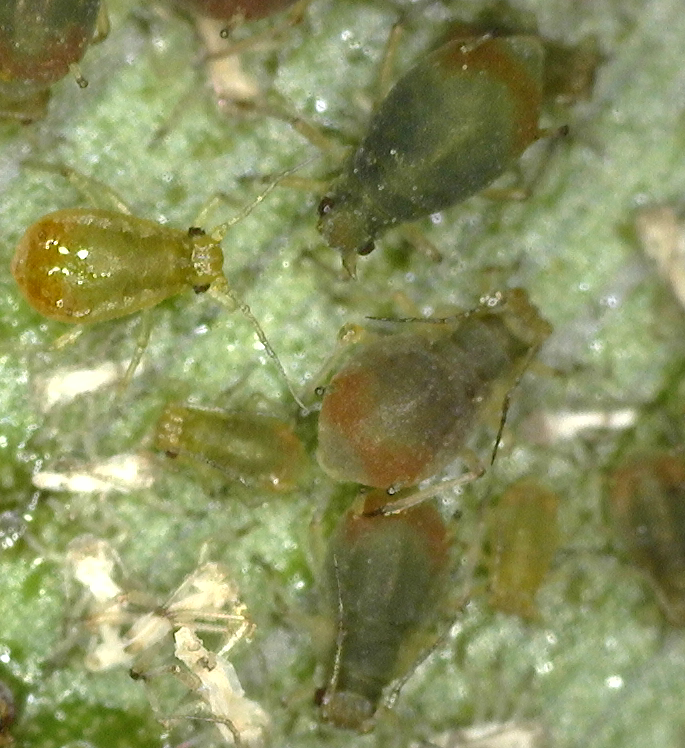Comparing Pyrethroids to Manage Aphids in Insectide Treated and Untreated Wheat Seed
Raul T. Villanueva, Carl Bradley, Yaziri Gonzalez, and Rocio Davila
University of Kentucky
INTRODUCTION
Commercial winter wheat seed (cv Pioneer26R1A) without and with insecticide seed treatment (Poncho® (clothianidin)) were planted into no-till research plots of the University of Kentucky’s Research and Education Center in Princeton, KY. Aphid populations were monitored since planting and through the growing season, from November 2017 to May 2018. Aphids are the most important key pest of wheat. Two species, the bird cherry oat aphid (Rhopalosiphum padi), and the English wheat aphid (Sitobion avenae) (Fig. 1) are the most common in wheat in western Kentucky. Of these two species, bird cherry oat aphids are the most effective vectors of barley yellow dwarf virus (BYDV). For the control of aphids, prophylactic preventative pyrethroid sprays are a common practice in Kentucky. Pyrethroids are sprayed in the fall, mid-winter and spring. Also, many farmers have been planting insecticide treated seeds against early stage pests. The latter is a recent practice that has been put into action probably less than 10 years ago. Nevertheless, this cultural practice is not a 100% implemented by wheat farmers of Kentucky.
The objectives of this study were:
to evaluate three pyrethroid sprays to manage aphids in wheat, and
to compare the impact of seed treatment on yields.
FIGURE 1.
DIFFERENT STAGES OF BIRD CHERRY OAT APHID
IMMATURE ENGLISH GRAIN APHID; NOTICE ITS DISTINCTIVE DARK AND LARGE CORNICLES.
PROCEDURES
Untreated Pioneer® 26R1A seed and insecticide treated seed (Pioneer® 26R1A) were planted in two contiguous 300-ft by 7-ft plots (length and width, respectively). Each plot was divided in experimental units consisted of 20-ft with 5-ft alleys between plots. After wheat emergence, aphid populations were monitored. Sampling consisted on searching and tallying aphids on 1 foot of row length of wheat (at the bottom and along the entire plant foliage) for aphids during the fall 2017, and winter and spring 2018. The insecticides used and rates are indicated in Table 1. Insecticide spray were conducted on May 1, 2018. Each treatment was replicated 4 times. At maturity, yields were evaluated. All aphid densities and wheat weights were analyzed using Statistica® 13.3 (TIBCO® Software Inc.).
RESULTS AND DISCUSSION
During the fall 2017 and winter 2018 aphids were found sporadically. From March until mid-April 2018, aphids remained low. By the end of April 2018 aphid presence was most notorious however, their number did not exceed the economic threshold of 10 aphids per foot of row (for more than 60 days post emergence) (Figures 2a and 2b). The most common species was the bird cherry oat aphid. Tallies conducted 1 and 3 days after spray shown that mean number (±SEM) of aphids on all pyrethroid sprayed plots were significantly reduced (p < 0.05) compared with the populations in untreated control plots.
Although in this study aphid pressure in December was low; predicting aphid population densities for earlier stages of development currently is almost impossible. Based on these numbers; pyrethroid sprays should have not be conducted, but as explained above most farmers or consultants make prophylactic sprays for aphids even at earlier stages of wheat development, and when aphids are at low numbers or undetectable. From a researcher point of view, and given the conditions presented here, insecticide seed treatments were not necessary. However, from the farmer’s point of view, the decision is tough. This decision is complex and based on economic and yield losses. If there is a high aphid density, aphids may affect wheat at the most vulnerable stage of development (emergence to tillering) for BYDV transmission that may reduce yields, thus the choice would be to use insecticide seed treatments
FIGURE 2. NUMBERS OF APHIDS (±SEM) ON 1 FOOT OF ROW LENGTH ON WHEAT (cv. PIONEER® 26R1A) (a) UNTREATED SEED; AND (b) INSECTICIDE TREATED SEED WITH PONCHO®, 3 DAYS BEFORE, AND 1 AND 3 DAYS AFTER THE INSECTICIDE SPRAY. DIFFERENT LETTER ON EACH DATE SHOWN SIGNIFICANT DIFFERENCES (p<0.05) AMONG TREATMENTS AFTER FISHER’S LSD TEST. (SPRAY DATE: MAY 1, 2018)
It is important to notice that there is still some controversy about the impact of seed treatments on other crops (i.e. corn, and soybeans). Studies conducted on insecticide seed treatments in southern states have shown a positive impact, resulting in lower numbers of pests presented after plant emergence in cotton, soybean and corn. Whereas studies conducted with insecticide seed protection in states north of Tennessee did not show the same impact. Insect pests are present at high pest pressures in the south compared with northern states.
Wheat yields were tallied for all plots however, there was a malfunction in the combine after harvesting the 300-ft row of untreated seed plants. The next 300 ft row containing all treatments of insecticide treated seed had lower unreliable yields.




